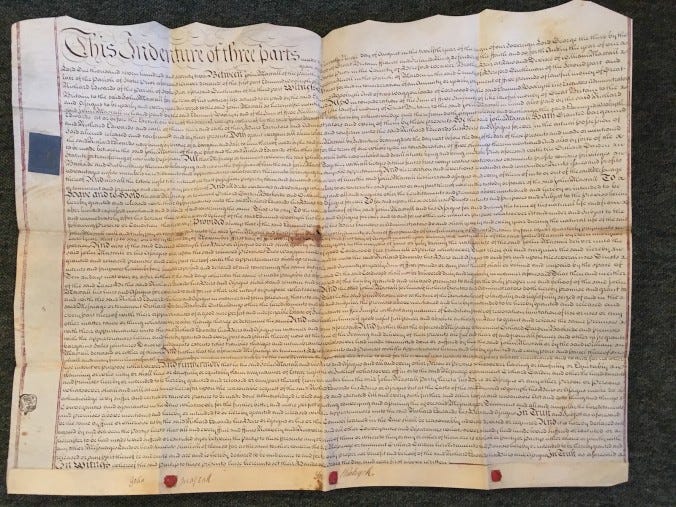In which we find the original-ish deeds to the cottage
How old is The Dingle actually? Well, we still don’t know, but now we have a clue…
FROM THE ARCHIVES
When we bought The Dingle back in March 2016, all the deeds and paperwork and whatnot were at the mortgage company (I think). They asked us if we’d like them back, or if they should get rid of them.
UM WE’LL HAVE THEM BACK, PLEASE!
And we’re so glad we did because the deeds are absolutely stunning.
The earliest record of sale that we have — beautifully written on vellum and parchment — is from 1772.
One John Mascall sold The Dingle — conveying messuage, orchard, garden, with appurtenances — to a Mr Edwards.
We’re not sure if this was the first sale of the house, or just the earliest record we have; but either way, it seems likely that the house dates from the late-1600s to mid-1700s. We’ll keep digging, and take the whole lot to the Records Office in Hereford at some point.
I spent an afternoon at the Records Office back in 2016 and had a root through the 1841 census records. The Dingle was in use as a shop at that time, and I think was counted as two separate units — but I’m not sure.
I do know that George and Mary Bannar, their daughter, and their twin sons lived there during that census, and that George was an agricultural labourer – like most local able-bodied men at that time, I’d guess. It was a tiny cottage for five people to live in, because it was much smaller than it is now.
Was it a quarry?
What we really wanted to know from the Records Office, though, was whether The Dingle used to be a quarry. Village lore says it was. The elders of the village keep telling us that there was a quarry here, lots of the stone houses in the village were built with stone from the quarry, and that the quarry was on our land.
Our neighbours in Monkerton House down the lane insist that their (beautiful) old house, which was once the village forge, was built from stone from our quarry.
Fascinating stuff, but my research hasn’t yet shed any light on whether or not there was ever a quarry here.
The dingle (which means a deep wooded valley or dell) itself is definitely man-made: it’s a long, thin slice like a drover’s road in an otherwise uniformly steep slope. There are the bones of rocks poking out the sides. You can see on old maps that our dingle joined old roads that criss-crossed the whole area.
There’s also a mysterious alcove in the right-hand end wall of the cottage, which would have been right next to the end of any roadway running alongside the building. Perhaps it was a toll booth?
Detective mode on. Updates will follow (eventually).
When we’ve finished all the building work and decorating, we’ll definitely get that earliest deed framed, because it’s beautiful.





